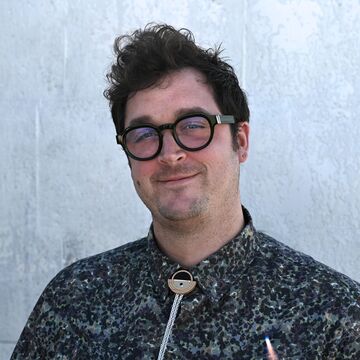|
Description
This team-taught, introductory course provides a foundation for most additional coursework in the Art and Technology Studies department. Students are given a broad interdisciplinary grounding in the skills, concepts, and hands-on experiences they will need to engage the potentials of new technologies in art making. Every other week, a lecture and discussion group exposes students to concepts of electronic media, perception, inter-media composition, emerging venues, and other issues important to artists working with technologically based media. Students will attend a morning & afternoon section each day to gain hands-on experience with a variety of forms and techniques central to technologically-based art making.
|
Class Number
1107
Credits
3
|
|
Description
Marx said that the kind of equivalence money creates between two disparate objects is essentially magic. What enables ¿spooky action at a distance¿ but money itself? For Trotsky, it was clear that a post-capitalist society would need *some* store of value: what if we could design money to value differently? Going beyond Andy Warhol¿s cheeky quip that ¿making money is the best art¿, this class aspires to see money, finance, blockchain technologies, and economic organization as creative media for individual, social, and metaphysical expression. As a studio/seminar, students should expect challenging and rewarding readings and discussion that drive the development of works within their practice. Occasional tutorials in new media areas (such as blockchain contracts and financial data visualization) are available but not required for students developing their final applied projects.
The course title plays on a couple of key texts on which the theoretical learning will hinge. The notion of capitalism as a form of sorcery is articulated by Isabelle Stengers and Pierre Pignare in their book Capitalist Sorcery: Breaking the Spell. Stengers frequently draws on witchcraft in her philosophy, such as in texts like ¿Reclaiming Animism¿. The course also deals with the concept of post-capitalism, which is a heterodox leftist notion of the creative potential beyond or after capitalism, which students will find in Brian Massumi - 99 Theses on the Revaluation of Value (a post-capitalist manifesto). The work of the artist duo FoAM, the experimental collective the Economic Space Agency, the 3Ecologies Institute, and Holly Herndon/Mat Dryhurst will inform students¿ work. The course title also alludes to a Cardi B song.
Students will give presentations on readings and create a final project using their own practices that exemplifies both material and conceptual rigor sufficient to the topic. The course will culminate in a course critique of a final project developed through the conceptual apparatus of the course.
|
Class Number
2392
Credits
3
|
|
Description
Post-modernist and post-structuralist art, architecture, literature, music and performance have often made overtures to the chaotic, while admitting the creative act always requires structuration driven by a more-than-human intentionality (see Cage¿s definition of music as ¿organized sound¿). Sidestepping aesthetics altogether, Feminist scholar Elizabeth Grosz understands art as a non-extraordinary rerouting of the chaotic forces of the earth to create a territory. A territory is a culture, a culture of intensities. For psychoanalyst and activist Felix Guattari, the artist, and perhaps exceptionally the improviser, must open themselves onto the cosmos ¿ which he calls the chaosmos. Despite historical adoration for chaos as a catalyst for creativity, appeals to chaos might feel exasperating in 2023. The founding scientists of chaos theory wrote ¿we grow in direct proportion to the amount of chaos we can sustain and dissipate¿ (Prigogyne and Stengers, 1984). Unexpected loss of human life in the pandemic, the rise of stochastic terrorism fueled by extremism, and the industrialized destruction of our very lifeworld ¿ haven¿t we had our fill of chaos? In four parts, this seminar charts a path across disciplines and between chaos and order in the creative act. First we begin with the scientific origins of chaos theory (Poincare¿s ¿three body problem¿), early systems theory (Von Uexhull¿s ecology), and Ilya Prigogine and Isabelle Stenger¿s seminal Order out of Chaos. Next we will fashion a cultural thermodynamics through science fiction (Cixin Liu, Ursula K. Le Guin) and feminist art theory (Grosz, Institute for Precarious Consciousness). We turn to the chaosmos (a chaotic cosmology) as articulated by activist and in-disciplinary thinker Felix Guattari as well as radical empiricist-pragmatists (Bergson, Dewey). Finally, we revisit the cybernetic bedrock of chaos theory: computation. We turn to both arguments about what it is (Galloway, Dhaliwal, Parisi), what we imagine it can do in a chaotic world(Turner, Curtis), and what we argue it can¿t do (Simondon, Yuk Hui). Students are encouraged to bring their own practices and perspectives to the readings and to a final paper. In addition to seminar discussions and student presentations about readings, students will choose to respond, elaborate, and interject into the course¿s discourse either through creative projects or papers.
|
Class Number
2091
Credits
3
|

